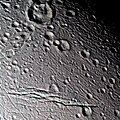Fitxer:EN004 Painting on the walls.jpg

Mida d'aquesta previsualització: 600 × 600 píxels. Altres resolucions: 240 × 240 píxels | 480 × 480 píxels | 1.000 × 1.000 píxels.
Fitxer original (1.000 × 1.000 píxels, mida del fitxer: 442 Ko, tipus MIME: image/jpeg)
Historial del fitxer
Cliqueu una data/hora per veure el fitxer tal com era aleshores.
| Data/hora | Miniatura | Dimensions | Usuari/a | Comentari | |
|---|---|---|---|---|---|
| actual | 03:52, 12 gen 2012 |  | 1.000 × 1.000 (442 Ko) | OgreBot | (BOT): Uploading old version of file from en.wikipedia; originally uploaded on 2005-06-03 01:20:58 by Volcanopele |
| 18:37, 9 ago 2005 |  | 600 × 600 (120 Ko) | Changcho~commonswiki | Image of Enceladus' surface taken by Cassini (NASA/ESA) on 9 March, 2005. Image shows tectonic features and crater degradation styles. {{PD}} |
Ús del fitxer
La pàgina següent utilitza aquest fitxer:
Ús global del fitxer
Utilització d'aquest fitxer en altres wikis:
- Utilització a als.wikipedia.org
- Utilització a ba.wikipedia.org
- Utilització a ca.wikinews.org
- Utilització a el.wikipedia.org
- Utilització a es.wikinews.org
- Utilització a fr.wikipedia.org
- Utilització a gl.wikipedia.org
- Utilització a hu.wikipedia.org
- Utilització a it.wikipedia.org
- Utilització a pl.wikipedia.org
- Utilització a ru.wikipedia.org
- Utilització a sk.wikipedia.org
- Utilització a sv.wikipedia.org
- Utilització a uk.wikipedia.org
- Utilització a vi.wikipedia.org
- Utilització a zh.wikipedia.org




